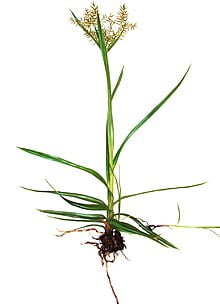Cyperus esculentus

Cyperus esculentus (also called chufa,[2] tiger nut,[3] atadwe,[4] yellow nutsedge,[5] and earth almond)[6] is a crop of the sedge family widespread across much of the world.[7] It is found in most of the Eastern Hemisphere, including Southern Europe, Africa and Madagascar, as well as the Middle East and the Indian subcontinent.[8][9][10] C. esculentus is cultivated for its edible tubers, called earth almonds or tiger nuts, as a snack food and for the preparation of horchata de chufa, a sweet, milk-like beverage.[11]
Cyperus esculentus can be found wild, as a weed, or as a crop. It is an invasive species outside its native range, and is readily transported accidentally to become invasive. In many countries, C. esculentus is considered a weed.[11][12] It is often found in wet soils such as rice paddies and peanut farms as well as well-irrigated lawns and golf courses during warm weather.
It has been suggested that the extinct hominin Paranthropus boisei (the “Nutcracker Man”) subsisted on tiger nuts.[13]
C. esculentus was one of the oldest cultivated plants in prehistoric and Ancient Egypt, where it was an important food. Roots of wild chufa have been found at Wadi Kubbaniya, north of Aswan, dating to around 16,000 BC.[14] Dry tubers also appear later in tombs of the Predynastic period, around 3000 BC. During that time, C. esculentus tubers were consumed either boiled in beer, roasted, or as sweets made of ground tubers with honey.[15] The tubers were also used medicinally, taken orally, as an ointment, or as an enema, and used in fumigants to sweeten the smell of homes or clothing.[16] Chufa continued to be an important source of food in the Dynastic period, and cultivation of the plant remained exclusively in Egypt.[17] The tomb of the vizier Rekhmire from the 15th century BCE, shows peasants preparing and measuring tiger nuts.[18] The modern name for tiger nuts in Egypt is حب العزيز (Hab el Aziz = grains of Al-Aziz) named after the Fatimid ruler who was reputedly fond of it.[19]
